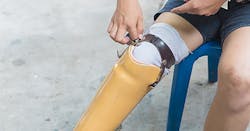The Occupational Safety and Health Administration (OSHA) has made a number of changes to update its National Emphasis Programs (NEP) aimed at reducing amputations in manufacturing industries by adding a targeting methodology for segments with high employer-reported amputation statistics.
OSHA noted that its enforcement history shows that employees are often injured when machinery or equipment is not properly guarded or maintained. “This NEP targets industrial and manufacturing workplaces having machinery and equipment that can potentially cause amputations,” the agency said.
The updated NEP targets industrial and manufacturing workplaces where employees are injured by unguarded or improperly guarded machinery and equipment. The program lists 75 North American Industry Classification System (NAICS) code industries that will fall under the enhanced inspection regime, including meat and poultry processing facilities, bakeries, wood, plastics and steel manufacturing facilities, among others.
NEPs are defined as temporary programs that focus OSHA's resources on particular hazards and high-hazard industries. Existing and potential new emphasis programs are evaluated using inspection data, injury and illness data, National Institute for Occupational Safety and Health (NIOSH) reports, peer-reviewed literature, analysis of inspection findings, and other available information sources.
This particular NEP has been in existence since 2006 and OSHA had previously updated it in 2015.
According to the agency, the most recently updated NEP revises targeting methodology to include data from amputation reporting requirements, and revises coding requirements for amputation inspections in the OSHA Information System. It also adds new appendices on amputations targeting methodology and NAICS codes.
OSHA compliance officers are instructed to evaluate employee exposure during setup, regular operation of the machine, clearing jams or upset conditions, making adjustments while the machine is operating, cleaning of the machine, oiling or greasing of the machine or machine pans, scheduled/unscheduled maintenance, and locking out and/or tagging out.
In addition, inspections will pay “particular attention to employee exposure to nip points, pinch points, shear points, cutting actions, and other points of operation,” the agency reported.
As was the case previously, OSHA will continue to select for inspection those industries that have received OSHA citations under the lockout/tagout standard and machine guarding standards. The agency will also pull from industries with high Bureau of Labor Statistics (BLS) incidence rates for nonfatal occupational injuries and illnesses involving days away from work, and NAICS codes with 50 or more amputations per year. The revised NEP notes that OSHA will now also select industries based on employer-reported amputations.
The updated emphasis program provides a three-month period of education and prevention outreach, which will run until March 10. During this period, OSHA intends to continue to respond to complaints, referrals, hospitalizations and fatalities.
New enforcement activities will begin after the outreach period and remain in effect until canceled.
OSHA-approved state plans are expected to have enforcement procedures that are at least as effective as those in the agency’s update directive. “The enforcement policies and procedures for amputation inspections conducted by states with OSHA-approved state plans must be at least as effective as those contained in the update,” the agency added.
OSHA-approved state plans also are required to notify the federal agency within 60 days as to whether they intend to adopt policies and procedures identical to those in this Instruction or adopt or maintain different policies and procedures.
“For manufacturing employers, it is essential that management review and understand their obligations under OSHA’s machine guarding and lockout/tagout requirements, including utilizing effective machine guarding and energy control procedures and ensuring that employees are appropriately trained on these procedures,” say attorneys Brent Clark, Kay Bonza and Craig Simonsen of the Seyfarth Shaw law firm.
“A proactive review of existing machine guarding methods and safeguards will go a long way towards being prepared when OSHA shows up for a programmed, planned inspection,” they advise.
About the Author

David Sparkman
David Sparkman is founding editor of ACWI Advance, the newsletter of the American Chain of Warehouses Inc. He also heads David Sparkman Consulting, a Washington, D.C. area public relations and communications firm. Prior to these he was director of industry relations for the International Warehouse Logistics Association. Sparkman has also been a freelance writer, specializing in logistics and freight transportation. He has served as vice president of communications for the American Moving and Storage Association, director of communications for the National Private Truck Council, and for two decades with American Trucking Associations on its weekly newspaper, Transport Topics.
